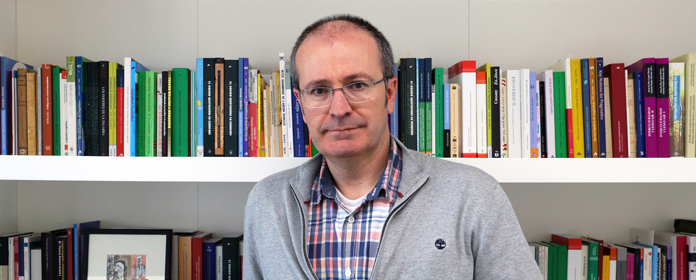"Language is the heart of culture and orality is an indication that a language is alive."
Asier Barandiarán, expert in bertsolaritza, collaborates with a project of research on creativity and oral language in the Institute for Culture and Society of the University of Navarra.

PHOTO: Natalia Rouzaut
Oral genres have been present in all cultures, but most of them have lost importance nowadays in favor of writing. One of the great exceptions is the bertso, sung and improvised verses in Basque.
According to Asier Barandiaran, professor at department of Didactics of language and Literature at the University of the Basque Country, "bertso is currently a thriving genre". This can be explained by its good organization - there are institutions that research bertsolaritza, documentation centers and schools where it is taught - as well as because it has been able to unite "tradition and modernity", he points out.
For the expert, orality is still present today, since a large part of the information we receive is through audiovisual and non-written media. In fact, he affirms that "language is the heart of culture and orality is an indication that a language is alive", since in oral creativity we can see "how we create language, how we use tradition, how we use prefabricated elements, our capacity to create new images, ideas...".
To know how the human mind can generate such complex manifestations as oral poetic representations is the purpose of the project ORFORCREA, developed by Marie Curie Sarali Gintsburg at the Institute for Culture and Society University of Navarra. Asier Barandiarán has joined as partner to investigate together with Sarali the different oral traditions and the cognitive instructions of creativity in verbal art.
Among the traditions they address, Sarali has focused on the Jbala, an oral poetic tradition from northern Morocco. Orality has a series of tendencies or patterns that are common to different cultures and languages," says Asier, "including the Jbala. Both experts agree on the similarities of these traditions: both are linked to the traditional and rural world. In addition, the communicative and compositional strategies and even certain rhetorical techniques are quite similar.
Women and bertsolaritzaThe first documentary references to bertsolaritza, as we know it today, date back to the beginning of the 19th century. They were oral interpretations in squares and taverns, often in the form of competitions. However, Barandiaran assures that the first testimonies of improvised bertsolaritza come from women who, as for example the funeral songs of Milia de Lastur (15th century) and as in many cultures, sang improvising at funerals.
"In the world of orality, in general, women have played a very important role," she says. However, she regrets that, during the 19th and 20th centuries, women were relegated to the background. "This has been turned around in recent decades where, thanks to, for example, the bertsolaris schools, women have begun to take part in different bertsolaritza events," she adds. In fact, the current champion of bertsolaritza is a woman, Maialen Lujanbio -who, by the way, will give a session at the ICS on May 16-.
In the beginning, aspiring bertsolari had to learn to create their verses by listening a lot, watching others and creating mental rules. All this changed in the 1980s with the appearance of the first ' bertsolarisschools'. They explained how to create bertsos step by step through the 'zu ere bertsolari' method based on the book of the same name by Xabier Amuriza. Barandiaran affirms that, at present, there are "highly developed materials and very suitable teachers for learning bertsos", including texts, audiovisual material, exercises... "Bertsolaritza is no longer something almost magical and is beginning to be taught as something that can be learned", he explains.
As the researcher states, learning may start with text but quickly moves on to orality and improvisation. To create a bertso, he expounds, "you first have to take into account the topic you have been given or what your partner has told you through the bertso" since most bertsolaristic events have to do with competition. And the bertso begins to be composed at the end. So the bertsolari first thinks about what final effect he wants to give it, adjusted to a rhythm, rhyme and metric. Then, depending on that rhyme, he will have to look for a whole series of puntuak (points) or words that rhyme with that phrase.
Finally, he will perform a work of bete-lana: "He will have to fill in what is left of the bertso trying to give some sense while taking care of the metric". All this in less than a minute -even in seconds-, sung and improvised.
